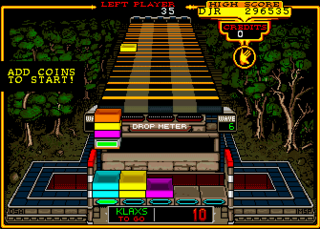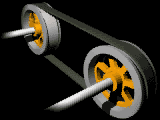
An ocean current is a continuous, directed movement of sea water generated by a number of forces acting upon the water, including wind, the Coriolis effect, breaking waves, cabbeling, and temperature and salinity differences. Depth contours, shoreline configurations, and interactions with other currents influence a current's direction and strength. Ocean currents are primarily horizontal water movements.

Klax is a 1990 puzzle video game designed by Dave Akers and Mark Stephen Pierce. The object is to line up colored blocks into rows of similar colors to make them disappear, to which the object of Columns is similar. Atari Games originally released it as a coin-op follow up to Tetris, about which they were tangled in a legal dispute at the time. Released in the summer of 1990, it is also known for being the last game ever to be released on the Atari 2600 before the console was discontinued in early 1992.

A baggage carousel is a device, generally at an airport, that delivers checked luggage to the passengers at the baggage reclaim area at their final destination. Not all airports use these devices. Airports that do not have carousels generally deliver baggage by placing it on the floor or sliding it through an opening in a wall.
The Chicago Area Consolidation Hub (CACH) is a package sorting facility for United Parcel Service, located in the village of Hodgkins, Illinois. One CTA bus route 169, four Pace bus routes, 390, 392, 395 and 890, serves this facility for weekday UPS shifts.

Purble Place is a suite of three computer games for children and teenagers. Developed by Oberon Games for Microsoft, it was introduced in Windows Vista and also is included in Windows 7.
The Grampus-class submarines were a group of minelaying submarines built for the Royal Navy in the late 1930s. These boats are sometimes referred to as the Porpoise class from the single prototype, HMS Porpoise built in 1932. Five boats to a modified design were built between 1936 and 1938. The ships were all named after marine mammals.
Material handling equipment is mechanical equipment used for the movement, storage, control and protection of materials, goods and products throughout the process of manufacturing, distribution, consumption and disposal. The different types of handling equipment can be classified into four major categories: transport equipment, positioning equipment, unit load formation equipment, and storage equipment.

A conveyor system is a common piece of mechanical handling equipment that moves materials from one location to another. Conveyors are especially useful in applications involving the transportation of heavy or bulky materials. Conveyor systems allow quick and efficient transportation for a wide variety of materials, which make them very popular in the material handling and packaging industries. They also have popular consumer applications, as they are often found in supermarkets and airports, constituting the final leg of item/ bag delivery to customers. Many kinds of conveying systems are available and are used according to the various needs of different industries. There are chain conveyors as well. Chain conveyors consist of enclosed tracks, I-Beam, towline, power & free, and hand pushed trolleys.
A lineshaft roller conveyor or line-shaft conveyor is, as its name suggests, powered by a shaft beneath rollers. These conveyors are suitable for light applications up to 50 kg such as cardboard boxes and tote boxes.
A checkweigher is an automatic or manual machine for checking the weight of packaged commodities.
It is normally found at the offgoing end of a production process and is used to ensure that the weight of a pack of the commodity is within specified limits. Any packs that are outside the tolerance are taken out of line automatically.

A drum motor is a geared motor drive enclosed within a steel shell providing a single component driving pulley for conveyor belts.

A shrink tunnel or heat tunnel is a heated tunnel mounted over or around a conveyor system. Items have shrink film loosely applied; with heat, the film shrinks to fit snugly around the wrapped object.
An eddy current separator uses a powerful magnetic field to separate non-ferrous metals from waste after all ferrous metals have been removed previously by some arrangement of magnets. The device makes use of eddy currents to effect the separation. Eddy current separators are not designed to sort ferrous metals which become hot inside the eddy current field. This can lead to damage of the eddy current separator unit belt.

The Hsinta Power Plant or Hsing-ta Power Plant is a coal-fired power plant in Yong'an District and Qieding District in Kaohsiung, Taiwan. With a total installed capacity of 4,326 MW, the plant is Taiwan's second largest coal-fired power plant after the 5,500 MW Taichung Power Plant.
Japanizi "Going, Going, Gong!" ("ゴーイング、ゴーイング、ゴング!") is a Canadian children's physical game show with a Japanese motif where contestants compete with a teammate against other teams as they tackle obstacles and challenges to test their mental capabilities, strength, endurance, and smarts. The series first aired on YTV starting November 5, 2013 and in the United States on Disney XD as of November 4, 2013.

Tirupati Laddu or SriVari Laddu is the laddu sweet offered as Naivedhyam to Venkateswara at Tirumala Venkateswara Temple in Tirupati, Chittoor District, Andhra Pradesh, India. The laddu is given as prasadam to devotees after having the darshan in the temple. The laddu prasadam is prepared within the temple kitchen known as 'Potu' by the temple board Tirumala Tirupati Devasthanams. Tirupati Laddu received Geographical indication tag which entitles that only Tirumala Tirupati Devasthanams can make and sell it.
All in a Nutshell is a 1949 Donald Duck animated short film which was originally released on September 2, 1949 and produced by Technicolor and RKO Radio Pictures in Walt Disney Productions.
Automated conveyor roller condition monitoring is an emerging field that has risen out of the need to make bulk handling conveyors more reliable.











